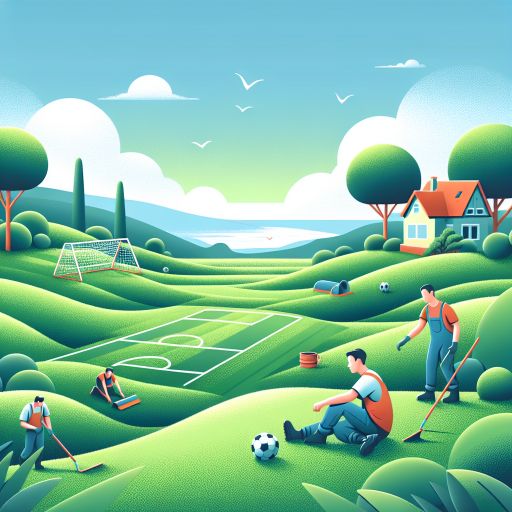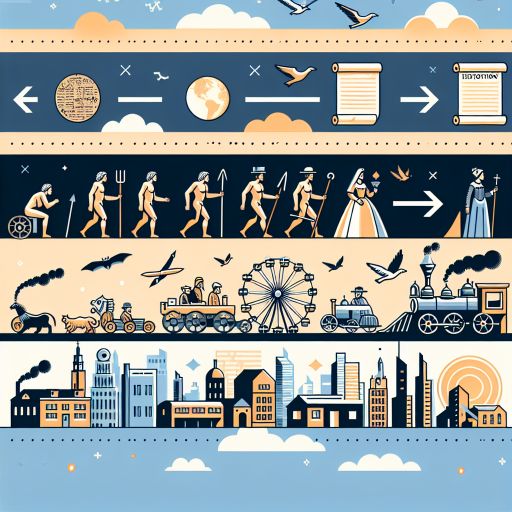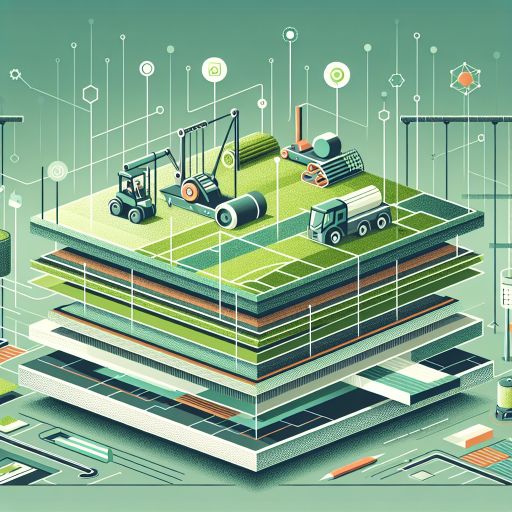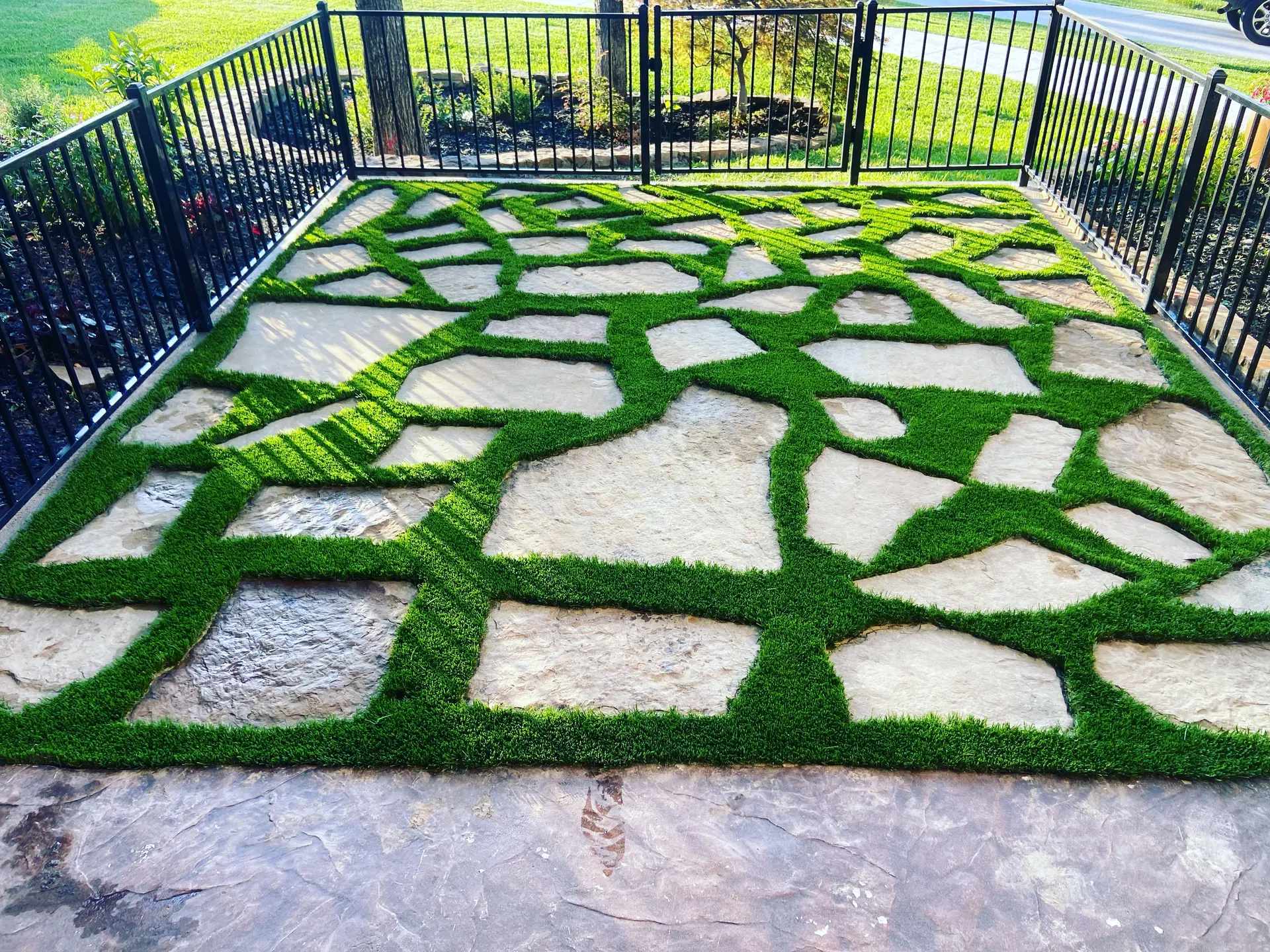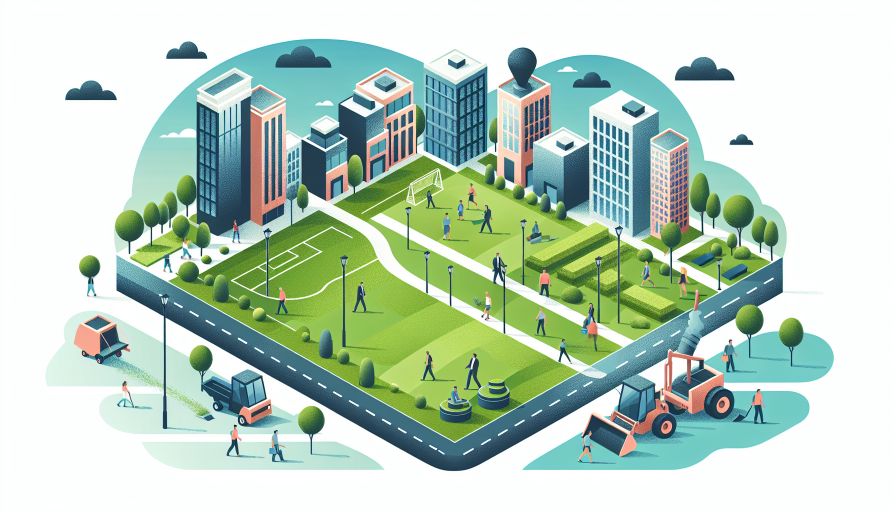
Introduction to Artificial Turf
Artificial turf, also known as synthetic grass, is a surface made of synthetic fibers designed to look and feel like natural grass. Originally developed for sports arenas, artificial turf has increasingly found applications in commercial landscaping for businesses and public spaces.
In recent years, technological advancements have significantly improved the quality and performance of artificial turf. It is now a viable alternative to natural grass for various commercial applications, offering several advantages such as reduced maintenance costs and year-round greenery.
Key components of artificial turf include:
- Polyethylene fibers: These form the “blades” of grass and are chosen for their softness and durability.
- Backing material: Typically made from polyurethane or latex, this provides support and structure to the turf.
- Infill: Made up of materials like sand or crumb rubber, infill helps to keep the blades upright and provides cushioning.
The growing adoption of artificial turf in commercial landscaping can be attributed to its numerous benefits over natural grass. These include lower water usage, reduced need for pesticides and fertilizers, and less frequent mowing. Additionally, artificial turf provides a consistent aesthetic appearance, regardless of weather conditions.
Comparison: Natural Grass vs. Artificial Turf
| Aspect | Artificial Turf | Natural Grass |
|---|---|---|
| Water Consumption | Minimal after installation | Requires regular watering |
| Maintenance Costs | Lower (no mowing, fertilizers, or pesticides) | Higher (mowing, fertilization, pest control) |
| Durability | High (10-15 years lifespan) | Variable (can be affected by weather, usage) |
| Appearance | Consistent year-round | Variable (affected by seasons and weather) |
Businesses and public spaces including parks, shopping centers, and corporate campuses are increasingly integrating artificial turf into their landscaping strategies. The flexibility and aesthetic reliability of synthetic grass make it an attractive choice for areas with heavy foot traffic or regions facing water scarcity.
Overall, the shift towards artificial turf in commercial landscaping represents a significant development, driven by economic, environmental, and practical considerations. Subsequent sections of this article will delve deeper into these factors and explore the broader implications of this trend.
Historical Context and Evolution
Artificial turf has come a long way since its inception, evolving significantly over the decades. The concept originally took root in the 1960s, when the first generation of artificial turf was developed and installed in the Astrodome, Texas, in 1966. Known as “AstroTurf,” it marked the beginning of a new era in sports and commercial landscaping.
First Generation: The initial generation of artificial turf was primarily composed of nylon fibers woven into a base fabric. While it provided a durable playing surface, it was criticized for being abrasive, leading to a higher risk of injuries and heat retention issues. This type of turf mainly found its applications in sports venues.
Second Generation: The 1970s and 1980s saw the advent of the second generation of artificial turf. Made from polypropylene, these surfaces were softer and less abrasive compared to their predecessors. However, issues concerning durability and maintenance persisted, limiting their widespread adoption.
Third Generation: The development of third-generation artificial turf in the late 1990s and early 2000s marked a significant turning point. These modern turfs used polyethylene fibers, which are softer, more resilient, and more natural-looking. Infills made of sand and rubber granules were introduced to enhance cushioning and reduce injuries. This generation of turf quickly gained popularity in both sports and commercial landscaping, as it provided a more realistic, safer, and lower-maintenance alternative to natural grass.
In addition to sports venues, third-generation artificial turf began to be used extensively in public spaces, playgrounds, and commercial landscaping, owing to its versatility and durability.
Recent Innovations and Fourth Generation
Recent years have witnessed further innovations, leading to the development of fourth-generation artificial turf. Modern advancements include:
- Higher Durability: Enhanced materials and manufacturing techniques have significantly increased the lifespan and wear resistance of artificial turf.
- Improved Safety: Advances in infill technology and shock-absorbing underlays have further reduced the risk of injuries.
- Better Aesthetics: New fiber structures and color variations have resulted in more natural-looking turf that closely mimics the appearance of real grass.
- Environmental Considerations: Eco-friendly materials and recycling initiatives have been integrated to address environmental concerns associated with artificial turf.
These continual advancements underscore the evolution of artificial turf from a niche solution for sports venues to a mainstream option for various commercial and public applications, revolutionizing the landscaping industry in the process.
Economic Benefits for Businesses
The installation of artificial turf in commercial landscapes offers numerous economic benefits for businesses. One of the most significant advantages is the reduction in maintenance costs. Traditional grass requires regular mowing, fertilizing, watering, and pest control. In contrast, artificial turf largely eliminates these recurring expenses. According to a report by the Synthetic Turf Council, businesses can save up to 50% to 70% on water bills alone by switching to artificial turf.
Furthermore, synthetic grass installations require fewer resources over time. There is no need to purchase lawn care equipment or invest in professional landscaping services. The Artificial Turf Supply Company estimates that businesses save approximately $25,000 to $50,000 annually on maintenance costs per sports field. Extrapolating these figures to commercial spaces, similar financial benefits can be expected.
Another economic benefit is the increased durability and lifespan of artificial turf. Whereas natural grass can be damaged easily by heavy foot traffic or adverse weather conditions, high-quality synthetic grass is designed to withstand such challenges. Research from Visiongain suggests that artificial turf can last 10 to 20 years. This durability translates to fewer replacements and lower overall expenditures in the long run.
Businesses also benefit from fewer disruptions to operations. Natural grass areas often require periodic closures for maintenance, negatively affecting customer access and potentially leading to revenue losses. Artificial turf, however, remains consistently usable, thus ensuring that commercial spaces can remain open and attractive to clients and employees alike without frequent interruptions.
Moreover, the aesthetic appeal of artificial turf can also have an indirect positive economic impact. Well-maintained and visually appealing landscapes attract more customers and create a more inviting atmosphere. A study by the International Society of Arboriculture found that attractive landscapes can increase property values by up to 20%. This factor is especially crucial for businesses in retail or hospitality sectors where first impressions significantly influence customer behavior.
Lastly, tax incentives and rebates offered in various regions for implementing sustainable and water-efficient landscaping solutions can further enhance the economic viability of artificial turf. For example, the Metropolitan Water District of Southern California’s turf replacement program offers substantial rebates for businesses that replace natural grass with synthetic alternatives, providing an immediate financial reprieve to adopting businesses.
In conclusion, the economic benefits for businesses that invest in artificial turf are multifaceted, ranging from direct cost savings on water and maintenance to indirect financial advantages through enhanced durability and increased property value. By adopting synthetic grass, businesses can achieve a more sustainable, cost-effective, and aesthetically pleasing environment.
Environmental Impact and Sustainability
Artificial turf has become an increasingly popular choice in commercial landscaping and public spaces due to its significant environmental benefits and sustainability aspects. Understanding the ecological footprint and long-term environmental impact of artificial turf can help businesses and urban planners make informed decisions.
Water Conservation
A substantial advantage of artificial turf is its role in water conservation. Natural grass requires regular watering to maintain its appearance and health, especially in arid climates. According to the U.S. Environmental Protection Agency (EPA), a well-maintained lawn can use up to 25,000 gallons of water annually. In contrast, artificial turf does not need watering, thereby significantly reducing water usage and conserving this vital resource.
Reduction in Chemical Usage
Maintaining natural grass lawns typically involves the use of fertilizers, pesticides, and herbicides, which can run off into waterways and cause environmental pollution. The EPA notes that around 70 million pounds of pesticides are applied to lawns in the United States each year. Artificial turf eliminates the necessity for these chemicals, thereby reducing the risk of chemical runoff and promoting a healthier environment.
Carbon Footprint and Emissions
Artificial turf can also contribute to reducing carbon footprints. Traditional lawn maintenance equipment, such as gas-powered mowers, emit significant amounts of greenhouse gases. According to the EPA, one hour of lawn mowing with a gasoline-powered mower can produce as much pollution as driving a car 45 miles. Artificial turf does not require mowing, which helps in minimizing carbon emissions from maintenance activities.
Urban Heat Island Effect
One environmental concern associated with artificial turf is its contribution to the urban heat island effect. Synthetic materials can absorb and retain more heat compared to natural grass, potentially leading to higher temperatures in urban areas. However, this downside can be mitigated through proper installation techniques and the use of advanced materials designed to reflect sunlight and reduce heat retention. Research from the EPA suggests that using light-colored and reflective materials can help alleviate this issue.
Recyclability and Waste Management
Another important aspect of the sustainability of artificial turf is its recyclability. Modern artificial turfs are increasingly being manufactured with eco-friendly materials that can be recycled at the end of their lifespan. According to a study published in the Journal of Cleaner Production, recycling artificial turf can significantly reduce its environmental impact, avoiding landfill waste and promoting the circular economy model.
- Water conservation benefits
- Reduction in chemical usage
- Lower carbon emissions and reduced maintenance
- Mitigation of urban heat island effect
- Recyclability and waste reduction
Technological Advances in Artificial Turf
In recent years, technological advances have significantly enhanced the performance, appearance, and application of artificial turf. These developments have played a crucial role in revolutionizing commercial landscaping for businesses and public spaces.
Material Science Innovations
One of the key areas of technological advancement in artificial turf is material science. Modern artificial turf is constructed using advanced polymer materials such as polyethylene, polypropylene, and nylon. These materials are engineered to improve durability, UV resistance, and softness, making the turf more resilient and visually appealing.
Advancements in fiber technology have led to the creation of fibers that closely mimic the look and feel of natural grass blades. New texturing techniques and fiber shapes, such as C-shaped and W-shaped blades, enhance the turf’s ability to stand upright and recover from foot traffic, further contributing to its realistic appearance and functional performance.
Backing and Infill Improvements
The artificial turf’s backing system has also seen significant technological improvements. Modern turf backing is designed to be highly porous, allowing for superior drainage and reducing the risk of waterlogging. This is particularly beneficial for high-traffic areas and regions with heavy rainfall.
Infill materials, which are used to support the turf fibers and provide cushioning, have evolved as well. Traditional sand and crumb rubber infill are now being supplemented or replaced with eco-friendly alternatives such as cork, coconut fibers, and recycled materials. These new infill options provide similar performance benefits while reducing environmental impact and improving safety.
Integration of Smart Technologies
Another exciting development in artificial turf technology is the integration of smart technologies. Sensors embedded within the turf can monitor various conditions such as temperature, moisture levels, and usage patterns. This data can be used to optimize maintenance schedules, ensuring the turf remains in top condition with minimal resource use.
Smart technologies can also enhance user experience in public and commercial spaces. For example, integrated lighting systems can be controlled to provide optimal visibility and ambiance for different times of the day and various events.
Heat Reduction Technologies
Artificial turf surfaces have been known to retain heat, sometimes reaching extremely high temperatures on sunny days. To address this issue, manufacturers have developed heat-reflective materials and cooling infill solutions. These technologies help to lower the surface temperature of the turf, making it more comfortable and safer for users.
Special coatings and reflective pigments are incorporated into the turf fibers to reflect more sunlight and absorb less heat. Additionally, cooling infill materials that retain moisture can help dissipate heat through evaporative cooling, providing a cooler surface.
Customization and Aesthetics
Advancements in artificial turf technology have also allowed for greater customization and aesthetic options. Businesses and public spaces can choose from a wide range of turf colors, blade lengths, and densities to achieve their desired look and functionality. Custom logos, patterns, and designs can be incorporated into the turf, offering unique branding opportunities and enhancing visual appeal.
Overall, these technological advances have significantly improved the quality, performance, and versatility of artificial turf, making it an increasingly attractive option for commercial landscaping in businesses and public spaces.
Case Studies of Successful Implementations
One of the most compelling ways to understand the impact of artificial turf on commercial landscaping is through real-world examples of successful implementations. Several case studies illustrate how businesses and public spaces have benefited from this technology.
Googleplex in Mountain View, California
The Googleplex, the corporate headquarters of Google, features extensive use of artificial turf in its campus landscaping. The use of synthetic grass helps the corporation maintain a lush, green environment all year round, significantly reducing water consumption and landscaping costs. Additionally, artificial turf has proven beneficial in high-traffic areas where natural grass would struggle to survive.
Central Park Conservancy, New York City, New York
In an effort to preserve its iconic green spaces, the Central Park Conservancy has incorporated artificial turf into various athletic fields. This implementation has led to fewer maintenance requirements and allowed more consistent availability for public use. Studies conducted by the Conservancy showed a decrease in maintenance costs and an increase in field utilization rates since the installation of artificial turf.
The Las Vegas Strip, Nevada
The Las Vegas Strip features high levels of foot traffic and extreme weather conditions, both of which pose challenges for natural grass. Many hotels and casinos along the Strip have adopted artificial turf for their outdoor areas to address these issues. The synthetic grass provides a visually appealing solution that requires minimal water and withstands high foot traffic, making it an economically viable option for these businesses.
Lurie Garden, Millennium Park, Chicago, Illinois
The Lurie Garden in Chicago’s Millennium Park uses artificial turf in certain sections to manage heavy foot traffic while retaining a clean, vibrant appearance. As a public garden that attracts millions of visitors annually, the use of synthetic grass reduces the need for constant upkeep, freeing up resources for other maintenance activities in the park.
Reebok Headquarters, Boston, Massachusetts
Reebok’s headquarters in Boston has incorporated artificial turf into its corporate campus to provide employees with recreational spaces that are functional throughout the year. The installation has led to enhanced employee satisfaction by offering an always-green space for sports and relaxation, regardless of weather conditions. This, in turn, contributes to a healthier work environment and increases employee engagement.
These case studies demonstrate the versatility and practical advantages of artificial turf in various settings. Whether for corporate campuses, public parks, or bustling commercial areas, the use of synthetic grass has proven to be a beneficial investment, providing long-term economic, environmental, and aesthetic benefits.
Future Trends and Innovations
Looking ahead, the future of artificial turf in commercial landscaping for businesses and public spaces presents numerous trends and innovations. These advancements promise to further enhance the functionality, aesthetic appeal, and sustainability of synthetic grass.
Development of More Sustainable Materials
One significant trend is the ongoing research and development of more sustainable materials for artificial turf. Manufacturers are increasingly experimenting with biodegradable or recyclable materials to minimize the environmental footprint. Innovations in bio-based polymers, derived from renewable sources like corn and sugarcane, are being explored as alternative raw materials for turf fibers.
Enhanced Realism
Another area of focus is creating artificial turf that mimics the look and feel of natural grass even more closely. Advances in fiber technology have led to multi-toned blades and varied blade shapes that better replicate the imperfections and variations found in living grass. The introduction of softer, more flexible materials also contributes to the tactile realism.
Improved Durability and Maintenance
Future trends also include the development of artificial turf that offers improved durability and reduced maintenance requirements. Research is leading to the production of fibers that are more resistant to wear and UV radiation. Additionally, systems are being designed to include better drainage to prevent water accumulation and promote faster drying times.
Integration with Smart Technology
The integration of smart technologies is another burgeoning field. Smart sensors embedded in the turf can monitor various conditions such as moisture levels, temperature, and usage patterns. This data can help in optimising maintenance schedules and detecting issues early, ultimately extending the life expectancy of the turf and maintaining its appearance.
Expansion into New Applications
Artificial turf is also expected to see expanded applications beyond traditional sports fields and commercial landscapes. Innovations in design and functionality are making it a viable option for rooftop gardens, urban parks, and indoor green spaces. The versatility of artificial turf opens up new possibilities for creative landscaping solutions in urban environments.
Table: Key Future Trends and Innovations in Artificial Turf
| Trend/Innovation | Description |
|---|---|
| Sustainable Materials | Use of biodegradable or recyclable materials to reduce environmental impact. |
| Enhanced Realism | Development of fibers that mimic the look and feel of natural grass more closely. |
| Improved Durability | Creation of turf that is more resistant to wear, UV radiation, and better drainage. |
| Smart Technology Integration | Incorporation of sensors to monitor conditions and optimize maintenance. |
| New Applications | Use of artificial turf in rooftops, urban parks, and indoor spaces. |
In summary, the future of artificial turf in commercial landscaping is poised to be driven by sustainability, improved realism, advanced durability, smart technology integration, and expanded applications. These innovations are set to revolutionize the industry, offering more versatile, long-lasting, and environmentally friendly landscaping solutions.
